This is an Ikko Sha Start 35 K-II 35mm camera made by Ikko Sha Co. Ltd. of Japan starting in 1958. It was the second to last model in Ikko Sha’s lineup of inexpensive Bakelite bodied 35mm cameras which started with the original Start from 1950. Although using 35mm film and making standard size 24mm x 36mm exposures, it used paper backed 35mm film loaded onto Bolta film spools which were originally developed for the Bolta Photavit series. The Start 35 K-11 had a top plate shutter release, flash synchronization, and two exposure settings for bright sunlight and shade.
Film Type: Unperforated 35mm paper backed film on Bolta Photavit spools
Lens: Unknown, probably ~50mm f/11 single element meniscus
Focus: Fixed Focus, probably 8 feet to Infinity
Viewfinder: Scale Focus
Shutter: Rotary Metal Blade
Speeds: Bulb and Instant, probably around 1/50
Exposure Meter: None
Battery: None
Flash Mount: Flash Sync Port, probably M and X since its a single speed shutter
Weight: 182 grams
Manual: None
How these ratings work |
The Ikko Sha Start 35 K-II is a fantastically small camera that is essentially a 35mm box camera. It has a focus free lens, single speed shutter, and only two diaphragm settings (small and large). The camera’s main body is made of Bakelite, and the metal pieces are chrome plated stamped steel. This is a cheap camera, but therein lies it’s charm. Using paper backed 35mm film, the camera still manages to eek out exposures with decent center sharpness, but extremely soft edges. The camera looks like no other, is extremely portable, and was fun to use. These things don’t show up for sale often, but if one were to ever cross your path, I’d recommend giving it a shot, if only as a curiosity. | ||||||
| Images | Handling | Features | Viewfinder | Feel & Beauty | History | Age | |
| 0 | 2 | 0 | 1 | 2 | 0 | 30% | |
| Bonus | +1 for “cool factor”, how many 35mm box cameras have you ever seen? | ||||||
| Final Score | 7.5 | ||||||
History
I pride myself in researching the history of the companies and cameras that I review. I don’t always dig up the most groundbreaking stuff, but I usually put together a decent amount of material for you to read. I’ve finally met my match.
This camera was made by a company called Ikko Sha Co. Ltd. of Japan starting in 1958. It was an upgraded model to an earlier Start model from 1950 that shot 24mm square exposures on unperforated paper backed 35mm film using the same type of spools that Bolta used in their Photavit series of cameras. Several sources online suggest the Start 35 K-II shoots the same 24mm square exposures as the earlier models, but this is incorrect. Aside from the difference in exposure size, the earlier models lacked a hinged film door, flash sync, and the metal top plate, but otherwise were the same.
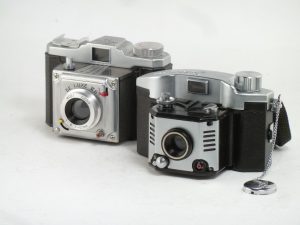
I believe that several Ikko Sha Start models were sold in various markets under different names and there may have been one other model in the Start lineup, called the Start-R which may have had a focusing lens, but I was unable to find any conclusive evidence. There was also another Japanese camera from the same time period called the Hoei Ebony Deluxe II S made by Hōei Sangyō Y.K. which shared many similar design traits. The Hoei Ebony used 828 format film which was another type of unperforated paper backed 35mm film so despite the change in film, the two cameras likely shot similar images. I have no idea if Hoei or Ikko-Sha had any relationship with one another or if the design similarities between the two are just a coincidence.
And, that’s about it. Like I said, I’ve met my match. I cannot find any other information about this camera or the company that made it, so if anyone reading this has anything additional to offer, please let me know!
My Thoughts
There are those cameras which you have longed for, sometimes for years, before finding one in good enough shape, or within your budget before finally adding them to your collection. And then there are those cameras you had no idea existed until the second before purchasing them. This camera is from the latter group.
I had been vaguely aware of a large industry of cheaply made Japanese cameras after World War II. Many Japanese models were simple, poorly constructed devices which were inferior to comparable cameras from Europe and the US. In fact, it was this poor reputation that allowed Nippon Kogaku to fly under the radar for the first few years after World War II making Nikkor lenses and Nikon cameras. It wasn’t until David Douglas Duncan and other LIFE magazine photographers started using them that anyone in the west even took a second glance at a Japanese made product.
The Ikko Sha Start 35 K-II being reviewed here is actually the third camera in my collection with the name “Start” after the KMZ Start 35mm SLR and the Pouva Start medium format camera. It is a later variant of the original Ikko Sha Start from 1950, and compared to that model is quite advanced. Even with it’s “upgrades” however, this thing is little more than a box camera that uses 35mm film. Maybe that’s not such a bad thing though, after all, some box cameras can still be quite capable.
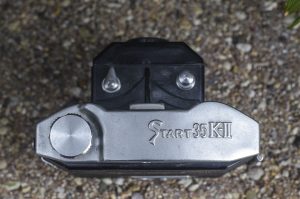
The top plate of the camera is rather spartan, but features a really nice embossed “Start 35 K-II” logo which eliminates any doubt to someone stumbling upon one of these, which model it is. Although the camera does use regular 35mm film, it is designed for unperforated paper backed film so there is only a film advance knob and no way to rewind it. On the black “shutter box” is a switch that selects between Bulb and Instant mode, and the shutter release. In some photos I’ve seen of this camera online, there is some type of screw-on collar around the shutter release which is missing from my example.
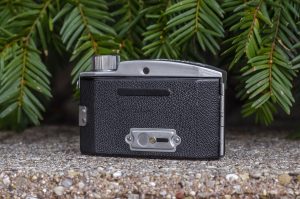
The back of the camera has the tiny viewfinder hole, and on the rear door, a sliding “peep” hole for reading the exposure numbers on the paper backing. Some articles online suggest this camera was designed for Kodak’s 828 format film, which is incorrect. In order for it to support 828, the exposure peep hole would have needed to be in the middle of the door, not near the bottom.
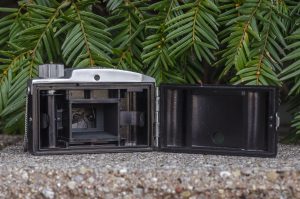
Opening the right hinged film door requires a mere tug of the door to overcome the “latch” that holds it shut. I had serious concerns with the camera’s ability to keep the door shut while out shooting, or it’s ability to prevent light leaks, so I was sure to apply a layer of electric tape around the entire perimeter of the door after loading film into it.
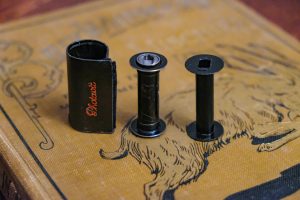
The film compartment resembles one from an 828 camera like the Kodak Bantam, but with a 24mm x 36mm film gate, and the same kind of spools that Bolta used in their Photavit series. A Photavit cassette will not fit inside of the Ikko-Sha, but the inner spool will. In the image to the right, you see a Photavit cassette, it’s inner spool, and the Start’s spool. Other than weight, the Photavit and Start spools are identical. The spool used in the Start is not the same as an 828 spool and is not interchangeable, so if you were to encounter one of these cameras and planned to shoot it, you’ll want to make sure there’s at least one spool in there. Two spools would be better, but one is all you need.

On the front is a selector that acts as a sort of diaphragm similar to box cameras, in which a metal plate with a slightly smaller hole covers the opening for the lens in an effort to “stop down” the lens for brightly lit scenes. The letters ‘S’ and ‘W’ indicate ‘Small’ and ‘Not Small’. Maybe W stands for ‘Wide Open’, I’m not really sure. I’ve never been able to locate a manual for this camera, but just know, that “S” is the smaller aperture (probably f/16) and “W” is ‘less small’ (probably f/11).
On the opposite site is a standard ASA flash sync connector which is unique to the later variants of the Start. Since the shutter has only a single speed, it could be considered “M & X at all speeds”. I don’t imagine many people who bought this camera would have done a lot of flash photography and even fewer probably used electronic flashes, but I guess it’s possible if you wanted to try. I didn’t.
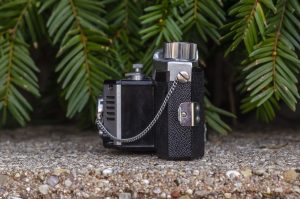
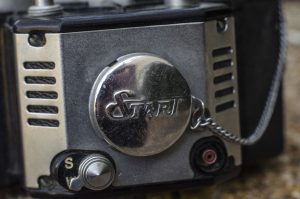
Finally, covering the lens is a chromed metal lens cap that is connected to the body with a metal chain, which reminds me of those chain wallets that were all the rage during the “grunge” era of the 1990s!
The bottom of the camera has nothing other than a standard 1/4″ threaded tripod socket. I question the usefulness of this, as the camera has no slow shutter speeds, a self-timer, or any method for connecting a shutter release cable, so any attempt at a long exposure would likely jar the camera.
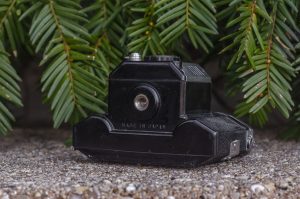
I mentioned earlier that using the Ikko Sha Start 35 K-II is like a 35mm box camera and that extends to the very tiny viewfinder. Although a straight through design, and not a reflex mirror like on box cameras, the similarity is there in that the viewfinder merely gives you an estimate of the exposed image. The view is very small and dark. I doubt the coverage is very accurate so even when looking through it, you’re still only getting an estimate of what you are about to shoot.
As I am proof-reading this article, you might get the impression that I didn’t like using the camera, but in reality, the opposite was true. The thing is so simple and unobtrusive, I found the process of shooting the film quite enjoyable. Other than choosing an Instant or Bulb (which I never used) shutter setting, and the small and large diaphragm, the whole process is just to point it at something at least 8 feet away and reasonably well lit and press the shutter release. You’re never going to impress Steve McCurry with any of your images, but that’s not the point. Once again, this is like a box camera in that you’re free to just enjoy the process and not worry about the complex details of shutter speeds or f/stops.
My Results
For what was likely the first roll shot in any Ikko Sha made camera in half a century, I decided to go with an expired roll of Polaroid 200 12-exposure film. This is my film of choice for many half frame cameras, but I decided to use it here as I knew the film compartment was cramped and I didn’t want to press my luck loading in a full 24 exposure roll.
Since the Start was designed for special paper backed 35mm film, I cut out the film from the normal 35mm cassette and taped one end to one spool (takeup) in complete darkness and then wound it into the other spool (supply) and inserted them in the camera. Since the camera has no light seals and there’s probably a 0% chance the rear exposure peep hole is light tight, I decided to use electric tape and completely cover the back of the camera and all seams around the door. I wouldn’t have an easy way of knowing how much to advance the film, but at least it should be light tight.
I didn’t have much of an expectation for the results of this camera when I was shooting it, so when I took the developed film out of my Paterson tank and saw images, I was elated. Upon scanning them into my computer, I saw (mostly) properly exposed images with extremely soft edges.
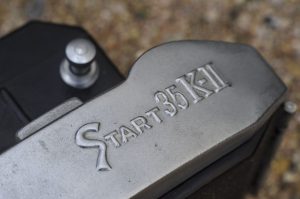
I’ve mentioned many times in this review how this camera is essentially a 35mm box camera and that is especially evident when you see the images. Center sharpness is surprisingly good, but boy does it drop off fast near the edges. Strangely, the left side of the exposures seem softer than the right, but they’re almost unusable. Earlier Start models shot 24mm square images and I think that it would have been a smart move to have kept the smaller square image as it would have cropped off the extremely soft edges. Colors are a tad muted which is likely due to the uncoated simple lens, but also partially due to me using expired color film.
As they are however, the Start 35 K-II makes wonderfully distinct photographs. This is a very uncommon camera, but had it been produced in greater numbers, I could see there being a demand for these by fans of the “LOMO movement” as it gives wonderfully “vintage” looking photos in an extremely compact and fun to use body.
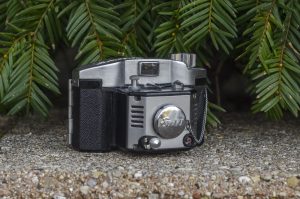
Loading your own film into the camera isn’t difficult at all. As long as you have at least one spool (two is better), and are willing to wrap the entire back of the camera in electric tape, you can easily shoot modern 35mm film in it. With the single shutter speed, I wouldn’t recommend shooting any film faster than ASA 100 outdoors.
Did I like the Start? Yeah! It’s a very neat camera that looks like nothing else in my collection, and I found it’s extremely portable size and easy controls to be liberating. Is it one I’ll likely shoot over and over? Probably not. For as easy as it was to shoot, the images have such a distinct look, I’d almost rather shoot a real box camera and benefit from the larger medium format negatives those usually make. Still it’s a cool little camera, and if one ever crosses your path, I recommend picking it up.
Additional Resources
http://camera-wiki.org/wiki/Start_35
https://www.flickr.com/photos/guylordat/25237197958/
http://www.collection-appareils.fr/x/html/camera-4803-Ikko%20Sha_Start%2035%20KII.html

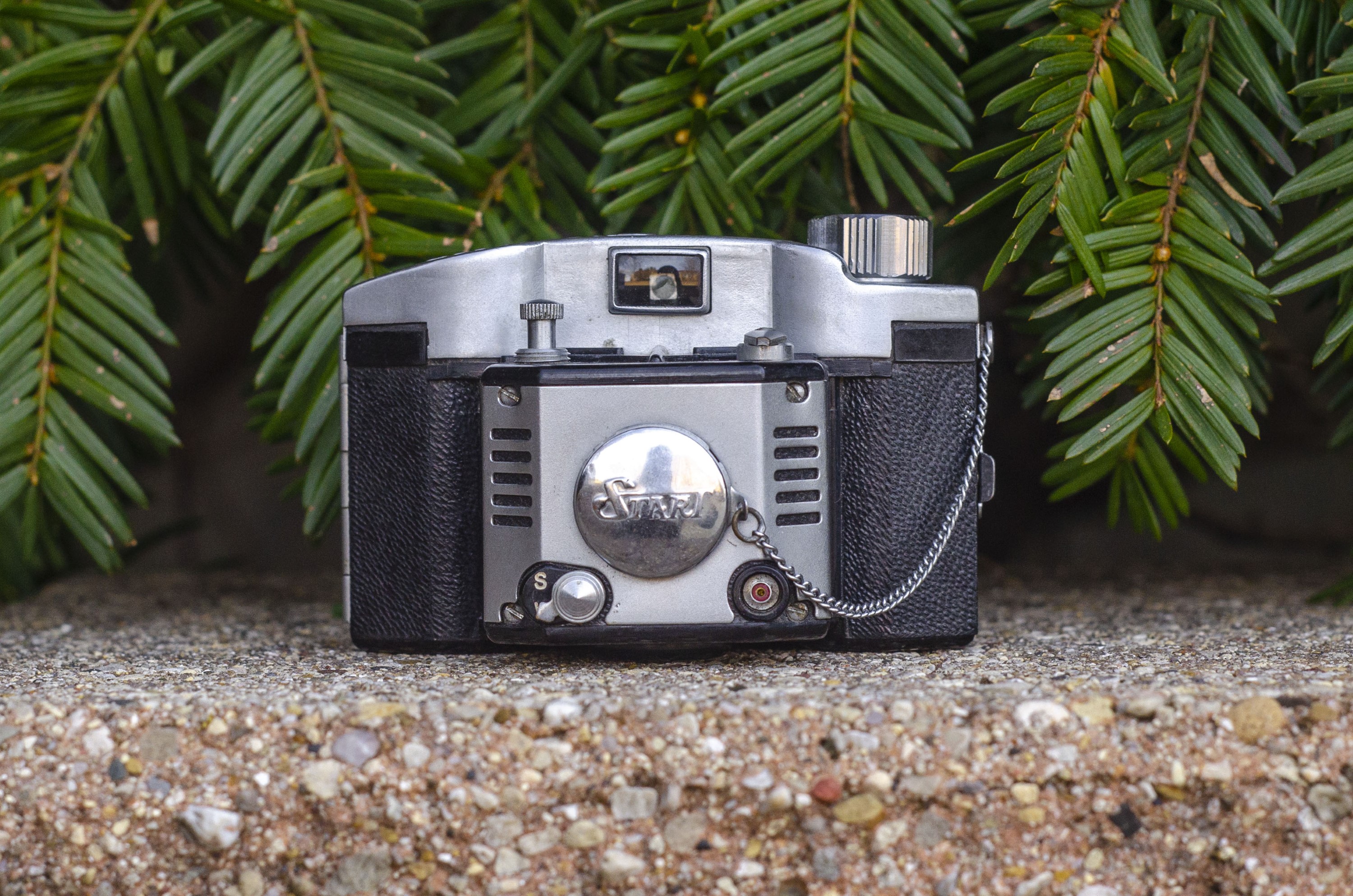
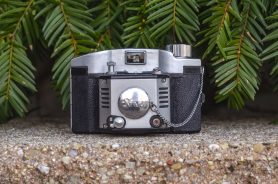









Wow! I have one but I’ve never even tried to use it. Your results are actually pretty cool. Thanks!
Nippon Kogaku was partly kept alive by supplying D-mount 13mm cine lenses to American camera makers such as Keystone and Revere. Little hard information is available about this, but I’d guess that a sharp salesman approached the American buyers and was able to underbid Elgeet and Wollensak, and earn the business. The Cine-Nikkor 13mm f1.9 is now overpriced on that “e” auction site, thanks to demand from owners of the Pentax Q. Here’s a link to an incredibly cool clock made using these lenses, from back in the day: https://www.ebay.com/i/231652510083?chn=ps
Great info Roger, although I suspect you meant to post this comment on something other than the Ikko-Sha Start 35! 🙂